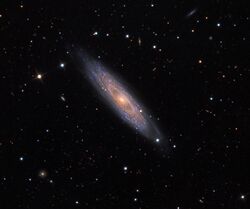Astronomy:NGC 7184
| NGC 7184 | |
|---|---|
 NGC 7184 by Adam Block/Mount Lemmon SkyCenter | |
| Observation data (J2000 epoch) | |
| Constellation | Aquarius |
| Right ascension | 22h 02m 39.8s[1] |
| Declination | −20° 48′ 46″[1] |
| Redshift | 0.008739 +/- 0.000010 [1] |
| Helio radial velocity | 2620 ± 3 km/s[1] |
| Distance | 99.3 ± 22.5 Mly (30.5 ± 6.9 Mpc)[1] |
| Apparent magnitude (V) | 11.1 |
| Characteristics | |
| Type | SB(r)c [1] |
| Apparent size (V) | 6.0′ × 1.5′[1] |
| Other designations | |
| UGCA 425, ESO 601- G009, MCG -04-52-009, PGC 67904[1] | |
NGC 7184 is a barred spiral galaxy located in the constellation Aquarius. It is located at a distance of circa 100 million light years from Earth, which, given its apparent dimensions, means that NGC 7184 is about 175,000 light years across. It was discovered by William Herschel on October 28, 1783.[2]
Characteristics
NGC 7184 has a small, bright nucleus and an elliptical bulge, whose major axis is aligned with the major axis of the disk. There is a bar along the minor axis of the bulge, but the high inclination of the galaxy makes its presence uncertain. From the bar emanate two tightly wound symmetrical spiral arms that form a bright inner ring.[3] The diameter of the ring along its major axis is 1.71 arcminutes.[4] The arms feature HII regions, and as they emerge from the ring are flocculent, based on the HII distribution, while they begin to split again at the outermost part of the galaxy.[5] Dust lanes are observed in the inner part of the disk.[6]
An outlying HII region has been discovered near NGC 7184. It is located on the major axis of the optical disk, on the northeasterly receding edge. Its size is estimated to be 270 pc at the distance of the galaxy and its Hα luminosity, 1037.6 erg s−1. It could be an isolated extension of a spiral arm.[7]
Supernova
One supernova has been observed in NGC 7184, SN 1984N. It was discovered visually by Robert Evans at magnitude 14, 60" east and 65" north of the nucleus on July 20, 1984. Its discovery was confirmed by T. Cragg at the Anglo-Australian Observatory.[8] Initially it was thought to be a variable star in our galaxy,[9] but later study of the object revealed it was indeed a supernova.[10][11] It was identified as type I.[12]
Nearby galaxies
NGC 7184 is the foremost galaxy of a small galaxy group known as the NGC 7184 group, which also includes NGC 7183.[13] A satellite galaxy lies 3 arcminutes to the south, at a projected separation of 28 kpc.[14]
References
- ↑ 1.0 1.1 1.2 1.3 1.4 1.5 1.6 1.7 "NASA/IPAC Extragalactic Database". Results for NGC 7184. http://ned.ipac.caltech.edu/cgi-bin/nph-objsearch?objname=NGC+7184.
- ↑ Seligman, Courtney. "NGC 7184". https://cseligman.com/text/atlas/ngc72a.htm#7184.
- ↑ Eskridge, Paul B.; Frogel, Jay A.; Pogge, Richard W.; Quillen, Alice C.; Berlind, Andreas A.; Davies, Roger L.; DePoy, D. L.; Gilbert, Karoline M. et al. (November 2002). "Near-Infrared and Optical Morphology of Spiral Galaxies". The Astrophysical Journal Supplement Series 143 (1): 73–111. doi:10.1086/342340. Bibcode: 2002ApJS..143...73E.
- ↑ Comerón, S.; Salo, H.; Laurikainen, E.; Knapen, J. H.; Buta, R. J.; Herrera-Endoqui, M.; Laine, J.; Holwerda, B. W. et al. (19 February 2014). "ARRAKIS: atlas of resonance rings as known in the S4G". Astronomy & Astrophysics 562: A121. doi:10.1051/0004-6361/201321633. Bibcode: 2014A&A...562A.121C.
- ↑ Meurer, Gerhardt R.; Hanish, D. J.; Ferguson, H. C.; Knezek, P. M.; Kilborn, V. A.; Putman, M. E.; Smith, R. C.; Koribalski, B. et al. (July 2006). "The Survey for Ionization in Neutral Gas Galaxies. I. Description and Initial Results". The Astrophysical Journal Supplement Series 165 (1): 307–337. doi:10.1086/504685. Bibcode: 2006ApJS..165..307M.
- ↑ Sandage, A., Bedke, J. (1994), The Carnegie Atlas of Galaxies. Volume I, Carnegie Institution of Washington
- ↑ Werk, J. K.; Putman, M. E.; Meurer, G. R.; Ryan-Weber, E. V.; Kehrig, C.; Thilker, D. A.; Bland-Hawthorn, J.; Drinkwater, M. J. et al. (1 January 2010). "Outlying H Ii Regions in H I-Selected Galaxies". The Astronomical Journal 139 (1): 279–295. doi:10.1088/0004-6256/139/1/279. Bibcode: 2010AJ....139..279W.
- ↑ "IAUC 3962: Prob. SN IN NGC 7184; APPULSE OF SAO 186001 TO NEPTUNE; JUPITER I (IO)". http://www.cbat.eps.harvard.edu/iauc/03900/03962.html.
- ↑ "IAUC 3994: 1983 TB; SN IN NGC 7184?". http://www.cbat.eps.harvard.edu/iauc/03900/03994.html.
- ↑ "IAUC 3995: Poss. N IN Sgr; EDITORIAL NOTICE; 1984o". http://www.cbat.eps.harvard.edu/iauc/03900/03995.html.
- ↑ "IAUC 4013: 1984t; SN IN NGC 7184". http://www.cbat.eps.harvard.edu/iauc/04000/04013.html.
- ↑ Spratt, C. E. (1987). "Visually discovered extra-galactic supernovae.". Journal of the American Association of Variable Star Observers 16 (1): 19–22. Bibcode: 1987JAVSO..16...19S.
- ↑ Makarov, Dmitry; Karachentsev, Igor (21 April 2011). "Galaxy groups and clouds in the local (z~ 0.01) Universe". Monthly Notices of the Royal Astronomical Society 412 (4): 2498–2520. doi:10.1111/j.1365-2966.2010.18071.x. Bibcode: 2011MNRAS.412.2498M. http://www.sao.ru/hq/dim/groups/galaxies.dat. Retrieved 12 December 2018.
- ↑ Zaritsky, Dennis; Smith, Rodney; Frenk, Carlos; White, Simon D. M. (20 March 1997). "More Satellites of Spiral Galaxies". The Astrophysical Journal 478 (1): 39–48. doi:10.1086/303784. Bibcode: 1997ApJ...478...39Z.
External links
- NGC 7184 on WikiSky: DSS2, SDSS, GALEX, IRAS, Hydrogen α, X-Ray, Astrophoto, Sky Map, Articles and images
 |
